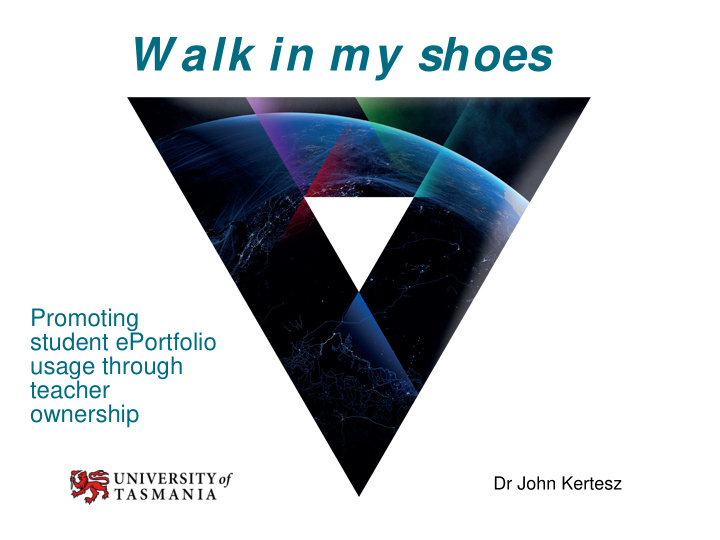



W alk in my shoes Promoting student ePortfolio usage through teacher ownership Dr John Kertesz
W alk in my shoes: Key points • Increased pressure for portfolio evidence of graduate capabilities • ePortfolio integration unsuccessful • Academic performance management ePortfolios may stimulate engagement I NSERT FACULTY NAM E I N FOOTER 2
Government & stakeholder pressure – Recommendation 27 - Pre-service teachers develop a Portfolio of Evidence to demonstrate their achievement of the Graduate level of the Professional Standards . W ALK I N M Y SH OES 3
Negative or ill-informed attitudes – no idea of how they are relevant – don't believe they are effective – Lack of familiarity – No real need – don't really look any different to a resume – a "useful repository" for students to CHOOSE to use W ALK I N M Y SH OES 4
Folio thinking culture Successful ePortfolio systems built upon a folio thinking culture are not dependent on the particular ePortfolio tool that is selected but on how the affordances of the tool….address the critical needs of the institution and various stakeholder groups (Light, Chen, & Ittelson, 2012) W ALK I N M Y SH OES 5
Common formula Justification + evidence artifacts + standards + ePortfolio = Attainment W ALK I N M Y SH OES 6
Now I know how students must feel! W ALK I N M Y SH OES 7
Trojan ePortfolio! W ALK I N M Y SH OES 8
Research questions 1. Does the construction of a professional ePortfolio improve lecturer engagement with, and ownership of, this medium? 2. Does lecturer personal use of ePortfolios increase their use of this form of assessment in their own teaching units? 3. What is the impact on teaching and learning of lecturers and students paralleling standards focused assessment of professional practice? I NSERT FACULTY NAM E I N FOOTER 9
Academic ePortfolio examples Academic 1 Academic 2 W ALK I N M Y SH OES 10
W ALK I N M Y SH OES 11
W ALK I N M Y SH OES 12
W ALK I N M Y SH OES 13
References • Bhika, R., Francis, A., & Miller, D. (2013). Faculty professional development: Advancing integrative social pedagogy using ePortfolio. International Journal of ePortfolio, 3(2), 117-133. • Brown, N., Kregor, G., & Williams, G. (2013). Technology enhanced learning and teaching white paper 2014-2018. UTAS: TILT. • Cambridge, D. (2010). Eportfolios for lifelong learning and assessment . San Francisco:Jossey Bass. • Challis, D, (2005). Towards the mature ePortfolio: Some implications for higher education. Canadian Journal of Learning and Technology , 31(3). • Danowitz, E.S. (2012). On the right track: Using ePortfolios as tenure files . International Journal of ePortfolio, 2(1), 113-124. • Light, T.P., Chen, H.L., & Ittelson, J.C. (2012). Documenting learning with ePortfolios: A guide for college instructors. San Francisco:Jossey Bass. • Meyer, B., & Latham, M. (2008). Implementing electronic portfolios: benefits, challenges, and suggestions. Educause Quarterly 1. • Miller, R., & Morgaine, W. (2009). The benefits of E-portfolios for students and faculty in their own words . Peer Review, 11(1), 8-12. • Ntuli, E., Keengwe, J., & Kyei-Blankson, L. (2009). Electronic portfolios in teacher education: A case study of early childhood teacher candidates . Early Childhood Education Journal, 37, 121-126. W ALK I N M Y SH OES 14
• Oakley, G., Pegrum, M., & Johnston, S. (2014). Introducing e-portfolios to pre-service teachers as tools for reflection and growth: lessons learnt . Asia-Pacific Journal of Teacher Education, 42(1), 36-50. • Penny, C, & Kinslow, J. (2006). Faculty perceptions of electronic portfolios in a teacher education program. Contemporary Issues in Technology and Teacher Education, 6(4), 418-435. • Swan, G. (2009) . Examining barriers in faculty adoption of an e-portfolio system . Australian Journal of Educational Technology, 25(5), 627-644. • Tosh, D., Light, T.P., Flemibg, K., & Haywood, J. (2005). Engagement with Electronic Portfolios: Challenges from the Student Perspective. Canadian Journal of Learning and Technology , 31(3). • Wang, X . (2009) . Comprehensive assessment of student collaboration in electronic portfolio construction: An evaluation research . Tech Trends, 53(1), 58-66. • Wetzel, K., & Strudler, N. (2006 ). Costs and benefits of electronic portfolios in teacher education: student voices . Journal of Computing in Teacher Education, 22(3), 99-108. • Wray, S. (2008). Swimming upstream: Shifting the purpose of an existing teaching portfolio requirement. The Professional Educator, 32(1), 35-50 • Wray, S. (2007). Electronic portfolios in a teacher education program . E-Learning, 4(1), 40-51. W ALK I N M Y SH OES 15
Recommend
More recommend